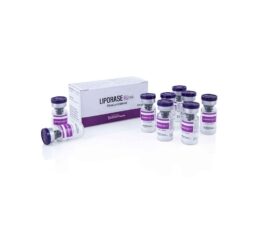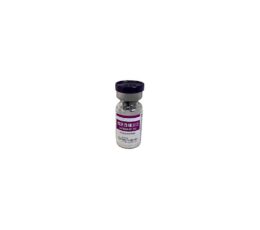Hyaluronidase
BUY HYALURONIDASE ONLINE
Hyaluronidase is an enzyme that breaks down hyaluronic acid, a key component in connective tissues. By hydrolyzing this substance, it enhances tissue permeability, aids in drug dispersion, and accelerates the body’s absorption of fluids. It’s widely used in medical and cosmetic fields for its permeability-boosting properties.
Showing all 2 results
10 Vials Hyaluronidase Liporase
Liporase Hyaluronidase comes in a set of 10 vials, each containing sterile lyophilized powder for reconstitution. With its recombinant human hyaluronidase, it aids in dispersing and absorbing injected drugs, particularly hyaluronic acid fillers. Convenient packaging ensures precise dosage administration and improved drug effectiveness, benefiting aesthetic and medical practices.
Hyaluronidase LDRASE 1 Vial
Hyaluronidase LDRASE 1 Vial contains recombinant human hyaluronidase, aiding in dispersing and absorbing injected drugs, particularly hyaluronic acid fillers. This sterile lyophilized powder, when reconstituted, enhances drug effectiveness, reducing filler complications. Single-use packaging ensures safety and convenience, benefiting both practitioners and patients in aesthetic and medical procedures.
Hyaluronidase
Hyaluronidase is a specialized enzyme that breaks down hyaluronic acid, a naturally occurring substance in the body responsible for maintaining skin hydration and elasticity. This enzyme is widely used in medical and aesthetic treatments to enhance tissue permeability, facilitate the dispersion and absorption of other injected drugs, and correct complications related to dermal fillers. Hyaluronidase’s unique properties make it an invaluable tool in both clinical and cosmetic practices.
Key Features and Benefits
1. Enhanced Tissue Permeability
Hyaluronidase increases tissue permeability by breaking down hyaluronic acid in the extracellular matrix. This process allows other substances, such as medications or fluids, to disperse more evenly and be absorbed more efficiently. This property is particularly useful in medical treatments where quick and effective drug dispersion is required.
2. Correcting Dermal Filler Complications
One of the primary uses of hyaluronidase in aesthetics is to correct issues related to hyaluronic acid-based dermal fillers. If a filler is over-injected, misplaced, or causes adverse reactions, hyaluronidase can dissolve the filler, providing a safe and effective solution for patients and practitioners.
3. Facilitating Drug Absorption
Hyaluronidase is used to enhance the absorption of subcutaneously or intramuscularly injected drugs. By breaking down hyaluronic acid, it allows for more rapid diffusion of injected medications, improving their efficacy and onset of action.
4. Aiding in Extravasation Management
In cases of extravasation, where IV fluids or medications inadvertently leak into surrounding tissues, hyaluronidase can be administered to promote the dispersion and absorption of these substances, reducing tissue damage and discomfort.
5. Surgical Applications
Hyaluronidase is used in various surgical procedures to improve tissue infiltration with local anesthetics, reducing the discomfort of the procedure and enhancing patient comfort. It is also used in ophthalmic surgery to facilitate the diffusion of anesthetic agents.
6. Wound Healing and Edema Reduction
Hyaluronidase has been shown to assist in wound healing and reduce edema by facilitating the breakdown of excess hyaluronic acid in tissues. This action helps to manage swelling and promote quicker recovery in various clinical scenarios.
Ingredients
Hyaluronidase products typically contain the enzyme derived from bovine or ovine sources, and they are carefully processed to ensure purity and efficacy. The formulation may include:
Active Ingredient
- Hyaluronidase: The primary active component, responsible for breaking down hyaluronic acid in tissues.
Excipients
- Sodium Chloride: Helps maintain isotonicity of the solution.
- Buffering Agents: Ensure the solution remains at an optimal pH for stability and activity.
Treatment Protocol
Initial Consultation
Before administering hyaluronidase, a thorough consultation with a qualified healthcare provider is essential. This step ensures that hyaluronidase is the appropriate treatment and that any potential allergies or contraindications are identified.
Preparation
- Solution Preparation: Hyaluronidase is typically supplied as a lyophilized powder that must be reconstituted with a suitable solvent, such as saline or sterile water, to the desired concentration.
- Patient Preparation: The treatment area is cleaned and sterilized to reduce the risk of infection.
Injection Process
- Dermal Filler Correction: When used to dissolve hyaluronic acid fillers, small amounts of the reconstituted hyaluronidase solution are injected directly into the area where the filler needs to be dissolved.
- Drug Dispersion: For enhancing drug absorption or managing extravasation, hyaluronidase is injected subcutaneously or intramuscularly in the affected area.
- Anesthetic Infiltration: In surgical or dental applications, hyaluronidase is mixed with local anesthetics and injected to enhance the distribution and efficacy of the anesthetic.
Post-Treatment Care
- Monitoring: Patients are monitored for any adverse reactions or allergic responses immediately after the injection.
- Aftercare Instructions: Specific aftercare instructions are provided based on the treatment type. For dermal filler corrections, patients are advised to avoid touching or massaging the treated area for a specified period.
Frequency of Treatments
The frequency and number of hyaluronidase treatments depend on the specific indication and patient response. For dermal filler corrections, a single session is often sufficient, whereas for drug absorption enhancement, the treatment may be administered concurrently with the other medications as needed.
Expected Results
Immediate Effects
- Dermal Filler Correction: Results are usually seen within minutes to hours, with the undesired filler volume visibly reduced.
- Drug Absorption: Enhanced drug dispersion and absorption typically occur rapidly, improving the therapeutic outcomes.
Long-Term Results
- Sustained Improvement: Long-term benefits include the resolution of adverse filler effects and improved efficacy of injected drugs.
- Wound Healing: Continued use in wound management can result in reduced edema and enhanced healing over time.
Suitability
Ideal Candidates
- Patients with Filler Complications: Those needing correction of hyaluronic acid-based dermal fillers.
- Enhanced Drug Absorption: Individuals requiring rapid and effective dispersion of injected medications.
- Surgical Patients: Those undergoing procedures where improved anesthetic diffusion is beneficial.
Not Suitable For
- Allergic Individuals: Patients with known allergies to hyaluronidase or its components.
- Certain Medical Conditions: Those with conditions that contraindicate the use of hyaluronidase, as determined by a healthcare provider.
Risks and Side Effects
Common Side Effects
- Mild Discomfort: Some patients may experience temporary pain or discomfort at the injection site.
- Redness and Swelling: Minor redness and swelling may occur, typically resolving within a few hours to days.
- Bruising: Small bruises may develop at the injection sites.
Rare Side Effects
- Allergic Reactions: Rarely, patients may have allergic reactions ranging from mild to severe.
- Infections: Although uncommon, improper injection technique or aftercare can lead to infections.
- Local Irritation: Persistent irritation or sensitivity in the treated area.
Minimizing Risks
- Qualified Practitioner: Ensure the treatment is performed by a trained and experienced healthcare provider.
- Proper Aftercare: Adhering to all aftercare instructions can minimize the risk of complications.
Conclusion
Hyaluronidase is a versatile enzyme with a wide range of medical and aesthetic applications. From enhancing the dispersion and absorption of injected drugs to correcting dermal filler complications, hyaluronidase offers a safe and effective solution for various treatment needs. Its ability to improve tissue permeability, aid in wound healing, and facilitate surgical procedures makes it an indispensable tool for healthcare professionals. By delivering targeted and immediate results, hyaluronidase enhances patient outcomes and satisfaction in both clinical and cosmetic settings.
Disclaimer
Always consult with a healthcare provider to determine the most appropriate treatment for your specific condition. Individual results may vary, and consistent follow-up is essential for achieving and maintaining optimal outcomes.
professional all of the questions you have.


